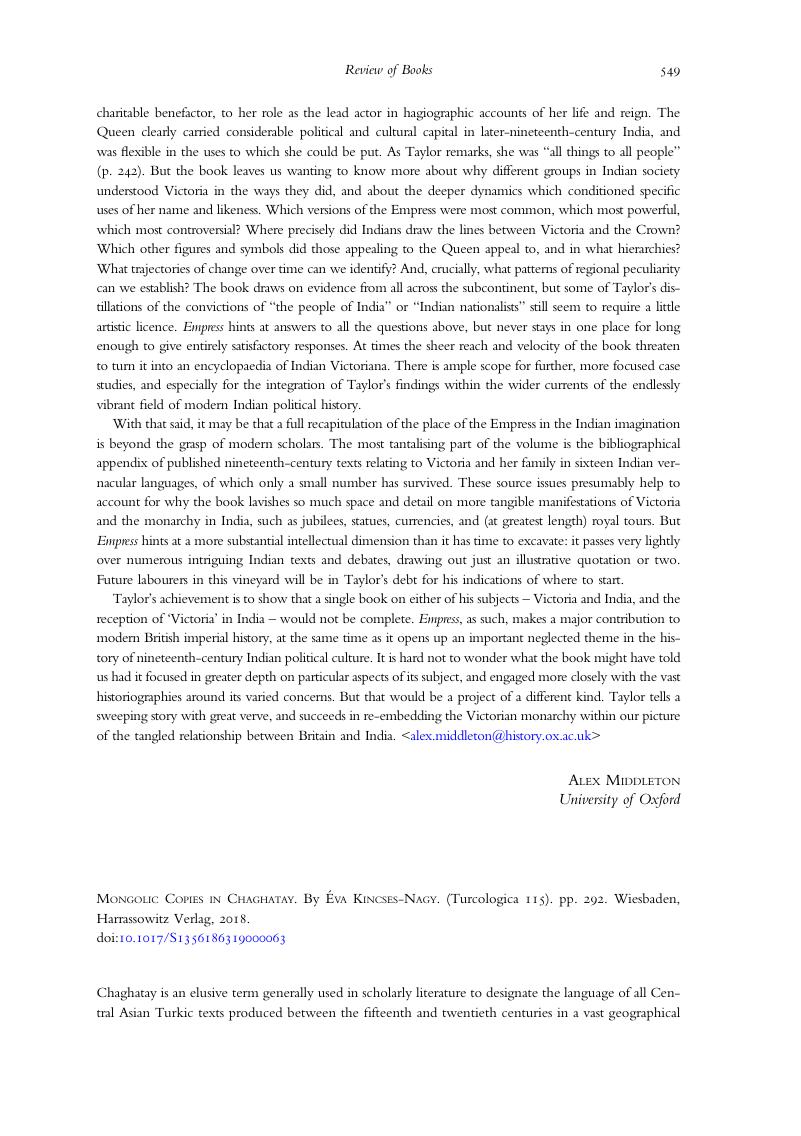No CrossRef data available.
Published online by Cambridge University Press: 20 March 2019

1 Hendrik Boeschoten–Marc Vandamme, Chaghatay. In: Csató, Lars Johanson–Éva Ágnes (eds.), The Turkic Languages (London and New York, 1998), p. 167Google Scholar.
2 For a detailed study on Mongolic loanwords in classical Persian see Doerfer, Gerhard, Türkische und mongolische Elemente im Neupersischen. I. (Wiesbaden, 1963)Google Scholar.
3 See e.g. the entries besärek (p. 62), bätäkä (p. 63), etc.
4 Natanzī, Muʿīn al-Dīn, Muntakhab al-Tawārīkh-i Muʿīnī. Istakhrī, Bi-ihtimām-i Parvīn. (Tehran, 1383), p. 295Google Scholar.
5 The word doesn't appear in Kincses-Nagy's wordlist. For a detailed description of yatughan see Doerfer, Türkische und mongolische Elemente I, pp. 546–550. Natanzī’s description of a feast speaks about two instruments of supposed Mongol origin, yatughan and shidirgu that were used to accompany singers specialised in singing Mongol tunes (yaruchiyān-i ayālghu-pardāz). Natanzī, Muntakhab, p. 295.
6 Eraslan, Kemal, ‘Ahmedî: Münazara (Telli Sazlar Atışması)’, Türk Dili ve Edebiyatı Dergisi 24 (1986), p. 154Google Scholar.
7 çïda-, çïray, çura-
8 For a comprehensive list of edited and published Chaghatay texts see Rahimi, Farhad, ‘Çağatay Türkçesi ve Edebiyatı Üzerine Bir Bibliografya Denemesi’, Turkish Studies 9:3 (2014), pp. 1157–1218CrossRefGoogle Scholar. For unpublished MA theses and PhD dissertations see the relevant homepage of the Turkish Council for Higher Education. https://tez.yok.gov.tr/UlusalTezMerkezi/giris.jsp [Last accessed 06. 11. 2018].
9 Goca, Ayet Abdülaziz, Hayder Tilbe'nin Mahzenü’l Esrâr Mesnevisi. Önsöz, Giriş, Metin ve Tercüme, Dizin. Tezi, Doktora. İstanbul Üniversitesi. (İstanbul, 2000)Google Scholar; Xorazmiy, Haydar, Gulshan ul-asror. In: M. Abduvohidova–H. Muxtorova–B. Qosimxonov–O. Jo'raev, Muborak maktublar. (Tashkent, 1987), pp. 211–216Google Scholar.
10 http://navoi.natlib.uz:8101/uz/ [Last accessed 06. 11. 2018]. A .pdf version of all the volumes is also accessible at the following homepage: http://n.ziyouz.com/kutubxona/category/40-alisher-navoiy-asarlari [06. 11. 2018].
11 The edition of the Shajara-i Tarākima prepared by Zuhal Kargı Ölmez contains a wordlist and notes on select words, some of them are included in Kincses-Nagy's book, that makes research on Abū al-Ghāzī’s vocabulary much easier. This edition is not included in Kincses-Nagy's bibliography. Han, Ebulgazi Bahadır, Şecere-i Terākime (Türkmenlerin Soykütüğü). Hazırlayan Zuhak Kargı Ölmez (Ankara, 1996)Google Scholar.
12 „Bu tārīkhnï yakhshï va yaman barchalari bilsün tep Türkī tili bilen aytdïm. Türkīni ham andaq aytïp men kim beş yaşar oghlan tüshünür bir kalima Chaghatay Türkīsindin, Fārsīdin, ʿArabīdin qoshmay men ravshān bolur” (In order to enable good and bad people to [fully] understand it I have written my chronicle in Turkic. I used Turkic in a way that even a five year old boy can understand it and it's clear that I avoided including words of Chaghatay, Persian and Arabic.) Desmaisons, P. I., Histoire des Mongols et des Tatars par Aboul-Ghazî Behâdour Khan (Amsterdam, 1970), 37Google Scholar.
13 Usmanov, Ivanics Mária–Myrkasim A., Das Buch der Dschingis-Legende (Däftär-i Dschingis-nāmä) (Szeged, 2002), 1Google Scholar.
14 Ross, E. Denison (ed.), The Mabânî’l-Lughat Being a Grammar of the Turki Language in Persian by Mirzâ Mehdi Khān (Calcutta, 1910), p. 1Google Scholar.
15 The critical edition of the Abushqa was published by Mustafa Kaçalin in 2011. Niyāzi, Nevâyî’nin Sözleri ve Çağatayca Tanıklar. El-Luġātu ’n-Nevā’iyye ve ’l-İştihādātu ’l-Caġātā’iyye. Hazırlayan Mustafa S. Kaçalin (Ankara, 2011)Google Scholar. Kincses-Nagy didn't use this edition.
16 Clauson, Sanglax f. 320v/26. The list of such words is quite long. See e.g. adïrġan (p. 39), amïdun (p. 47), dabusun (p. 89), düläy (p. 102), äläkä (p. 105), eljigän (p. 106), elinčig (p. 106), emägän (p. 107), ġašun (p. 110), etc.
17 It's not the only word termed foreign in the book. See e.g. dotur (p. 100), dörben (p. 101), ečigä (p. 104), elinčig (p. 106), ġašun (p. 110),etc.
18 Many of these words are termed by Kincses-Nagy ”temporary copies”.
19 Ross, The Mabânî’l-Lughat, p. 3.
20 Ross, The Mabânî’l-Lughat, p. 16.
21 Clauson, Sanglax f. 215r/19–20.
22 Hazai, İsmail Parlatır–György, Macar Bilimler Akademisi Kütüphanesi'ndeki Türkçe El Yazmaları Kataloğu (Ankara, 2007), pp. 455–459Google Scholar.
23 Fath ʿAlī relates in his preface to the dictionary that he was lucky to find a copy of Sanglakh at a private library and he had three days to consult it. Fath ʿAlī Qājār Qazwīnī, Fihrist-i Bahjat al-Lughat. Ms Török O. 325, f. 17b.
24 For a detailed account of the role Turkic played in Mughal India see Benedek Péri, Turkish Language and Literature in Medieval and Early Modern India. In: Poonawala, Ismail K. (ed.), Turks in the Indian Subcontinent, Central and West Asia. Turkish Presence in the Islamic World (New Delhi, 2017), pp. 227–262Google Scholar.
25 The meaning of the word given by Bābur is ’strong man’. Mirza, Zahiruddin Muhammad Babur, Bâburnâma. Part One. Chaghatay Turkish Text with Abdul-Rahim Khankhanan's Persian Translation. Turkish Transcription, Persian Edition and English Translation by W. M. Thackston, Jr. (Cambridge, Mass, 1993), p. 41Google Scholar.
26 Ebulgazi, Şecere-i Terākime, p. 201 (f. 95b/16).
27 Storey, Charles Ambrose, Persian Literature. A Bio-Bibliogrpahical Survey III/1 (Leiden, 1984), pp. 111–112Google Scholar.
28 Fazl Allāh Khān, Lughat-i Turkī (Calcutta, 1825), pp. 152, 154, 163. The first two words appear to be from a Qipchaq, the second two words from an Oghuz language.
29 Clauson, Sanglax, f. 259v/26–28; Mīr ʿAlī-shīr Nawāyī, Mahbūb al-Qulūb. (Ed.) A. N. Kononov (Moskva, 1948), p. 52 (text in Arabic script).
30 Atalay, Besim, Abûşka Lugatı veya Çağatay Sözlüğü (Ankara, 1970), pp. 145–146Google Scholar.
31 ʿAlī-shīr Nawāyī, Nawādir al-Nihāya. Ed. Aziz Kayumov (Tashkent, 1987), p. 592.
32 Atalay, Abûşka, p. 250. The 1993 Tashkent edition of Sadd-i Iskandarī contains one more couplet where the noun dapqur occurs. ʿAlī-shīr Nawāyī, Sadd-i Iskandarī. (Ed.) Sodir Erkinov (Tashkent, 1993), p. 487.
33 Yıldırım, Talip, Hüseyin Baykara Dîvânı. İnceleme, Metin, Dizin, Tıpkıbasım (İstanbul, 2010), p. 63Google Scholar.
34 Ölmez, Zuhal, Şecere-i Türk Sözvarlığından Örnekler. Türk Dilleri Araştırmaları 11 (2001), pp. 23–32Google Scholar; Ölmez, Zuhal, Ali Şir Nevâyî’nin Eserlerinde Moğolca Sözcükler II. Türk Dilleri Araştırmaları 25:2 (2015), pp. 183–206Google Scholar; Ölmez, Zuhal, Ali Şir Nevâyî’nin Eserlerinde Moğolca Sözcükler IV. Türk Dilleri Araştırmaları 26:1 (2016), pp. 137–138Google Scholar; Ali Şir Nevâyî’nin Eserlerinde Moğolca Sözcükler V. In: Özçetin, M. Ölmez–T. Çuha–K. (eds.), Dîvânu Lugâti't-Turk'ten Senglah'a Türkçe. Doğumunun 60. Yılında Mustafa S. Kaçalin Armağanı (İstanbul, 2017), pp. 513–520Google Scholar.